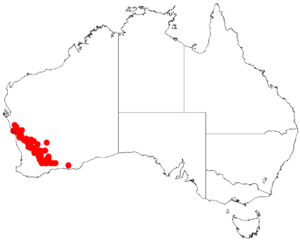Diels' wattle facts for kids
Quick facts for kids Diels' wattle |
|
|---|---|
| Scientific classification | |
| Genus: |
Acacia
|
| Species: |
dielsii
|
 |
|
| Occurrence data from AVH | |
Acacia dielsii, often called Diels' wattle, is a special kind of shrub. It's a native plant found only in Western Australia. This wattle belongs to the large Acacia family, which includes many types of Australian plants.
Contents
What Does Diels' Wattle Look Like?
This shrub usually grows between 0.5 and 2 meters (about 1.5 to 6.5 feet) tall. It has thin, pale green leaves, which are actually flattened stems called phyllodes. These leaves are straight or slightly curved. They are about 1 to 3.5 centimeters long and less than 2 millimeters wide.
Flowers and Seeds
Diels' wattle blooms from February to September. It produces bright yellow flowers. These flowers grow in small, round clusters, usually two clusters per leaf axil (where the leaf meets the stem). Each flower cluster is about 2.5 to 3.5 millimeters across and holds 8 to 17 golden flowers.
After the flowers, the plant forms seed pods. These pods are quite fragile and break easily into single seed units. The pods can be up to 3 centimeters long and about 1.2 to 1.8 millimeters wide. Inside, they hold mottled tan seeds that are about 2.5 to 3 millimeters long.
How Diels' Wattle Got Its Name
The scientific name for Diels' wattle is Acacia dielsii. It was first officially described in 1904 by a botanist named Ernst Georg Pritzel. He worked with another botanist, Ludwig Diels, to study plants in Western Australia. The plant's specific name, dielsii, was chosen to honor Ludwig Diels.
For a short time, this plant was called Racosperma dielsii. But in 2006, it was moved back into the Acacia group. Acacia dielsii is closely related to two other wattles: Acacia nivea and Acacia obesa. These three plants are often grouped together by scientists.
Where Does Diels' Wattle Grow?
Diels' wattle is endemic to Western Australia. This means it grows naturally only in that part of the world. You can find it in the Mid West, Wheatbelt, and Goldfields-Esperance regions.
It likes to grow in flat areas, sandy plains, and low hills. It prefers gravelly, sandy soils, especially near a type of rock called laterite. Its main area is a belt stretching from the Murchison River catchment in the north (east of Kalbarri) down to Newdegate in the southeast. You might also find some scattered groups as far south as Ravensthorpe. It often grows as part of open scrub and shrubland plant communities.

